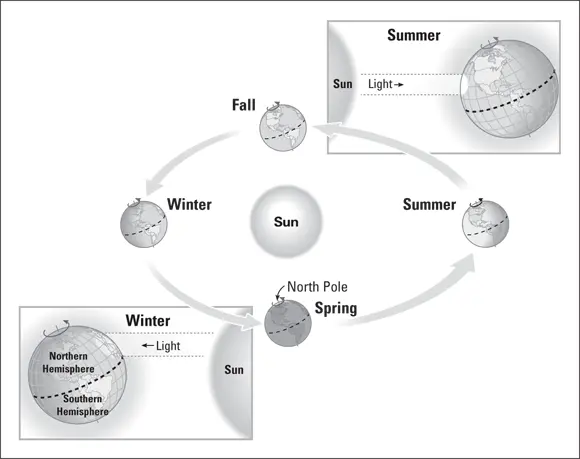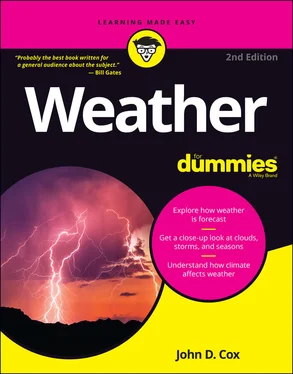Sure enough, it has to do with the elliptical shape of Earth’s orbit around the Sun (refer to Figure 3-6). This is gravity at work — the pull of the mass of the Sun on the Earth. When the Earth is closer to the Sun, the pull of gravity is stronger. Because it is farther from the Sun from March 20 to September 22, Earth travels more slowly during that loop of its orbit.
This means that summers are seven days longer in the Northern Hemisphere than in the Southern Hemisphere. Do they know this in Australia? Is this legal?
The sunlight’s angle affects its intensity in another way. The more directly the Sun is over your head, the less of Earth’s atmosphere it has to penetrate. Various things in the atmosphere filter out or scatter some of the incoming rays, so the more atmosphere it has to travel through, the more filtering and scattering takes place. ( Chapter 15says a lot about these optical effects.)
Earth is out of kilter. You might expect a well-behaved planet to stand up straight, and after 5 billion years or so, to act its age. But nope, not Earth. What can you do? Always it’s got this slant to it, like a slouchy teenager, as if it’s leaning against something. The angle of this tilt — the difference between where its poles are and where they would be if it were upright in relation to the Sun — is 23.5 degrees. When you come to think of it, this is quite a slant.
 This 23½-degree angle is why you have seasons. This is the whole reason why there is winter and spring and summer and fall. This tilt is why there is a time of year when plants are growing vigorously and another time when they are dormant. This slant of the Earth is the reason why January 3 and July 3 have a completely different feel. And this is why some times of year the Sun races across the sky and sets like a falling rock and at other times it just seems to hang up there all day long.
This 23½-degree angle is why you have seasons. This is the whole reason why there is winter and spring and summer and fall. This tilt is why there is a time of year when plants are growing vigorously and another time when they are dormant. This slant of the Earth is the reason why January 3 and July 3 have a completely different feel. And this is why some times of year the Sun races across the sky and sets like a falling rock and at other times it just seems to hang up there all day long.
If Earth were upright in relation to the Sun, still there would be weather, because still there would be cold air near the poles and warm air near the Equator for the atmosphere to contend with. And still there would be the cool and warm variations of night and day. But without the tilt, there would be no seasons.
My people at the Go Figure Academy of Sciences tell me that in a truly upright world, life as you know it would be very different. For one thing, everywhere on Earth all year long would get the same amount of daylight and darkness — exactly 12 hours. For another, there would be no tourist seasons.
As Figure 3-7 shows, this arrangement that gives the Earth the same slant in relation to the Sun throughout the year produces some interesting dates.
On about March 20, the vernal (or spring) equinox, and again on or about September 22, the autumnal (or fall) equinox, it happens that daylight and darkness is distributed evenly around the world — each lasting 12 hours.
Direct sunlight reaches its most northerly point on or about June 21, the summer solstice, over the Tropic of Cancer, an imaginary latitude line 23.5 degrees north of the Equator. In the Northern Hemisphere, this is sometimes called “the longest day” because it is the day of most daylight.
Likewise, on or about December 21, the beam of direct sunlight has reached its most southerly point, over the Tropic of Capricorn, 23.5 degrees south of the Equator. In the Northern Hemisphere, this is “the shortest day,” the day of least daylight. By the same token, at the other end of Earth’s tilt, in the Southern Hemisphere, these “longest” and “shortest” days are reversed.

FIGURE 3-7:Here is a close-up view of Earth’s 23.5-degree slant and how it affects the distribution of sunlight in the course of its yearlong revolution around the Sun.
These dates are often said to be the “first official days” of the various seasons, but take another look. Is December 21 really the first day of winter where you live? As my people say at the Go Figure Academy of Sciences, this is the kind of thing that can happen when you send an astronomer to do a meteorologist’s job! In most parts of the United States, if you haven’t been wearing your winter coat before December 21, you haven’t been keeping your promises to your mother. Likewise, by June 21, the day of the year when the Sun’s rays beat down directly over more of the Northern Hemisphere than any other, summertime has already become a pretty familiar feeling.
In the middle latitudes of the Northern Hemisphere, weather scientists generally think of the winter season as the months of December, January, and February, spring as March, April, and May, and so on. (From winter through autumn, Part 3goes into the details of the weather effects of these seasonal changes.)
You and I are part and parcel of Earth’s motions in space, and the planet’s atmosphere also is going along for the ride. Although Earthlings are traveling in a yearlong revolution around the Sun, speeding through space, they have no sensation of this movement. Thank goodness for that! Talk about being blown away!
Also, people have no sensation of dizziness even though the planet is spinning like a top in a rate of rotation that completes itself every 24 hours. A person standing at the Equator not only is traveling through space along with the planet, but at the same time is spinning with the planet at more than 1,000 miles per hour. It’s like a whirligig carnival ride, revolving on one level and spinning on another, and I’m getting a little queasy just thinking about it.
 The rotation or spin of Earth has a big impact on daily weather. Every moment, 24 hours a day, a new patch of the Earth is being exposed to the warming rays of the Sun after the cooling effects of darkness. Exactly around the world, a patch in daylight is becoming shrouded in the shade of the spinning planet. This constant routine is sending radiant heating and cooling through the atmosphere like a wave.
The rotation or spin of Earth has a big impact on daily weather. Every moment, 24 hours a day, a new patch of the Earth is being exposed to the warming rays of the Sun after the cooling effects of darkness. Exactly around the world, a patch in daylight is becoming shrouded in the shade of the spinning planet. This constant routine is sending radiant heating and cooling through the atmosphere like a wave.
Such is the fickle pace of many daily weather events. The hot summer afternoon can conspire with the moist air to produce a violent local storm of lightning and thunder and hail. The ground and the town below it can be left in a mess in an hour or two, and before long, the sky can show not the slightest sign of what happened.
Earth’s rotation is responsible for some very large and powerful weather-related motions in the atmosphere. For example, weather patterns in the middle latitudes move from west to east because of Earth’s spin. It is responsible for the west-to-east direction of the powerful polar jet streams and for the prevailing global winds, such as the tradewinds and the mid-latitude westerlies, which Chapter 5describes in detail.
The atmosphere, the weather’s home, begins at the tip of your toes and extends some 80 miles up, more or less. That may sound like a pretty deep sky, but relative to the size of the Earth, its thickness is less than a rind on an orange. And the layer of atmosphere where all the weather takes place is much thinner still — only about 10 miles thick — more like the skin on a peach. Only this skimpy layer, this peach fuzz, contains enough of the ingredients in the right proportion that you and I need to breathe. Does it strike you as odd, by the way, that people so seldom give this vital substance much thought? Go figure. So what exactly is this atmosphere — this precious stuff called air?
Читать дальше

 This 23½-degree angle is why you have seasons. This is the whole reason why there is winter and spring and summer and fall. This tilt is why there is a time of year when plants are growing vigorously and another time when they are dormant. This slant of the Earth is the reason why January 3 and July 3 have a completely different feel. And this is why some times of year the Sun races across the sky and sets like a falling rock and at other times it just seems to hang up there all day long.
This 23½-degree angle is why you have seasons. This is the whole reason why there is winter and spring and summer and fall. This tilt is why there is a time of year when plants are growing vigorously and another time when they are dormant. This slant of the Earth is the reason why January 3 and July 3 have a completely different feel. And this is why some times of year the Sun races across the sky and sets like a falling rock and at other times it just seems to hang up there all day long.
 The rotation or spin of Earth has a big impact on daily weather. Every moment, 24 hours a day, a new patch of the Earth is being exposed to the warming rays of the Sun after the cooling effects of darkness. Exactly around the world, a patch in daylight is becoming shrouded in the shade of the spinning planet. This constant routine is sending radiant heating and cooling through the atmosphere like a wave.
The rotation or spin of Earth has a big impact on daily weather. Every moment, 24 hours a day, a new patch of the Earth is being exposed to the warming rays of the Sun after the cooling effects of darkness. Exactly around the world, a patch in daylight is becoming shrouded in the shade of the spinning planet. This constant routine is sending radiant heating and cooling through the atmosphere like a wave.










